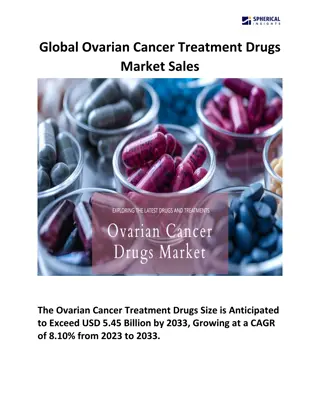Understanding Ovarian Follicles: Growth Stages and Cellular Composition
Ovarian follicles are the main functional units of the ovary, comprising an oocyte, granulosa cells, and theca cells surrounded by epithelial layers. The growth stages include primordial, primary, and secondary follicles, each characterized by specific cellular changes and development processes driven by follicle-stimulating hormone (FSH). These stages involve distinct cell arrangements and structures, leading to the formation of mature follicles ready for ovulation. Understanding the intricate details of ovarian follicle development is crucial in the context of female reproductive health and fertility.
Uploaded on Sep 17, 2024 | 0 Views
Download Presentation

Please find below an Image/Link to download the presentation.
The content on the website is provided AS IS for your information and personal use only. It may not be sold, licensed, or shared on other websites without obtaining consent from the author. Download presentation by click this link. If you encounter any issues during the download, it is possible that the publisher has removed the file from their server.
E N D
Presentation Transcript
Ovarian follicles An ovarian follicles consists of an oocyte, granulosa cells, and theca cells surrounded by one or more layers of epithelial cells. the follicles that are formed during fetal life, main functional unit of the ovary. Stages of follicular growth: _Primordial follicles: -consist of a primary oocyte enveloped by a single layer of the flattened follicular cells form a simple squamous epithelium around the oocyte. -Beginning in puberty with the release of follicle- stimulating hormone (FSH) from the pituitary, a small group of primordial follicles each month begins a process of follicular growth. This involves growth of the oocyte, proliferation and changes.
_Primary follicle: Prompted by FSH, an oocyte grows most rapidly during the first part of follicular development, reaching a maximum diameter of about 120 m.the nucleus enlarges; numerous and uniformly distributed, contain the following: A)Primary unilaminar follicle: contain a primary oocyte and follicular cells form a simple columnar epi. Around the oocyte. B)Primary multilaminar follicle: -follicular epithelium, the granulosa, in which the cells communicate through gap junctions. Follicle cells are now termed granulosa cells, the follicular cells continue to proliferate , forming a stratified granulosa cells. -Between the oocyte and the granulosa cells, a layer of extracellular material a homogenous glycoprotein membrane called zona pellucida develops. -theca folliculi, a layer located outside the basement membrane of the follicular cells mitochondria become more
_Secondary or antral follicles: -As the follicles grow with increasing oocyte size numbers of granulosa cells, they move deeper in the ovarian cortex. -Small spaces develop within the granulosa layer as the cells secrete follicular fluid or (liquor folliculi). -This fluid accumulates in the spaces gradually and the granulosa cells reorganize themselves around a larger cavity, the antrum, producing follicles now called secondary or antral follicles. Follicular fluid: contains hyaluronate, growth factors, plasminogen, fibrinogen, the anticoagulant heparan sulfate proteoglycan, and steroids (progesterone proteins. and high concentrations with of &estrogen) binding
-During the reorganization of the granulosa layer to form the antrum, some cells form a small hillock, the cumulus oophorus, surrounding the oocyte and protruding in to the antrum. -The granulosa cells immediately around and linked to the oocyte make up the corona radiata and accompany the oocyte when it leaves the ovary. -While the follicle develops, the stromal cells immediately around the follicle differentiate to form the follicular theca (theca folliculi), outer covering. -This layer subsequently differentiate further as two tissues around the follicle; a well vascular zed endocrine tissue, the theca interna( is composed of cells that secret the steroid hormone androgen) and a more fibrous outer theca externa containing smooth muscle and fibroblast.
-Follicular growth and maturation is influenced by follicle stimulating hormone (FSH), secret by the pituitary gland, and estrogen. _Mature graafian follicle: Follicle need 12-14 days to become fully matured, it is about 1cm in diameter, it shows a very large single antrum filled with follicular fluid. -The oocyte now in eccentric in position, projects in to this fluid-filled cavity, the oocyte is still surrounded by zona pellucida, still surrounded by granulosa cells which now make up the corona radiata (CR), outside the zona pellucida. -The corona radiata and oocyte are attached to the side of the follicle via a less mass of granulosa cells called the cumulus oophorus which is continuous with remaining granulosa cells.
Ovulation -ovulation consist of the rupture of part of the wall of the mature follicle and liberation of the oocyte( Ovarian wall ruptures and egg released, surrounded by its corona radiata).it takes place in approximately the middle of the menstrual cycle, around the fourteenth day of a 28- day cycle. Image:Gray3.png
-In the human, usually only one oocyte is liberated by the ovary during each cycle, but sometimes no oocyte is ovulated (anovulatory cycle). -Some time two or more oocytes can be expelled at the same time, and if they are fertilized, there may be two or more fetuses. -The stimulus for ovulation is a surge of luteinizing hormone(LH) secreted by the anterior pituitary gland in response to high levels of circulating estrogen produced by the growing follicles. -The increasing pressure of the follicular fluid and weakening of the follicular wall lead to rupture of the ovarian surface at the stigma.























